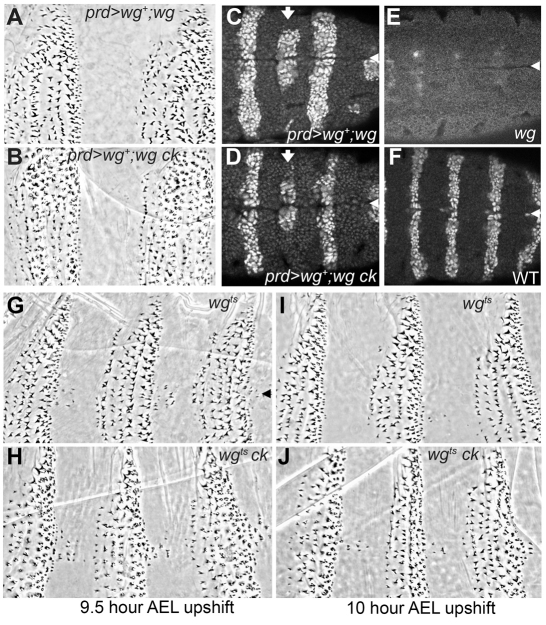Fig. 5.
Wg is required at late stages and at high levels for proper ck mutant denticle morphology. (A) prd-Gal4 driven UAS-wg+ transgene expression in the epidermal cells of odd-numbered segments rescues naked cuticle in a wgCX4 null mutant, and also denticle diversity in even-numbered segments. (B) In wgCX4ckKT9 double mutants, prd-Gal4 driven wg+ shows similar rescue, but most denticles remain rounded in appearance and there is some fragmentation of the large denticles. (C) Engrailed antibody staining in stage 10 prd>wg+;wgCX4 mutant embryos shows rescue and expansion of en expression in odd-numbered segments, and rescue at the ventral midline in even-numbered segments (arrow). Arrowheads in C-G mark the ventral midline. (D) The same degree of rescue is observed in wgCX4ckKT9 double mutants. (E,F) Without the rescuing transgene, en expression disappears from the epidermis of wg mutants by stage 10, compared with normal stripes of en expression in wild-type embryos at this stage (F). (G) Shifting wgts homozygous mutants up to restrictive temperature at 9.5 hours AEL results in a diverse denticle belt pattern but incomplete specification of the naked cuticle zone. (H) wgtsckKT9 double mutants shifted at the same time point show similar pattern effects but many denticles remain rounded in appearance, particularly the large posterior denticles. (I) Normal denticle patterning is largely restored in wgts mutants shifted up at 10 hours AEL, but morphological defects are still detected in the posterior-row denticles of wgtsckKT9 double mutants shifted at the same time point (J).

